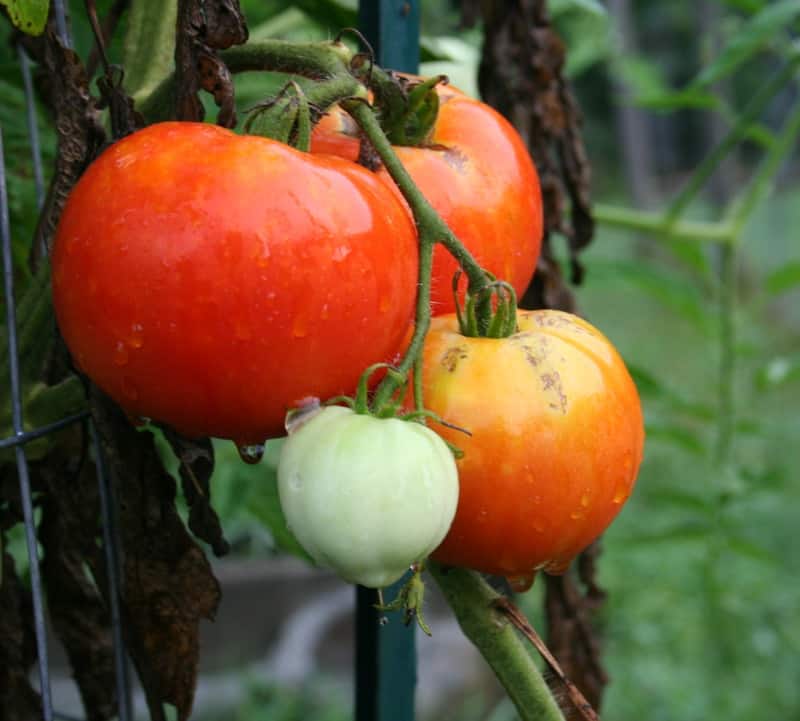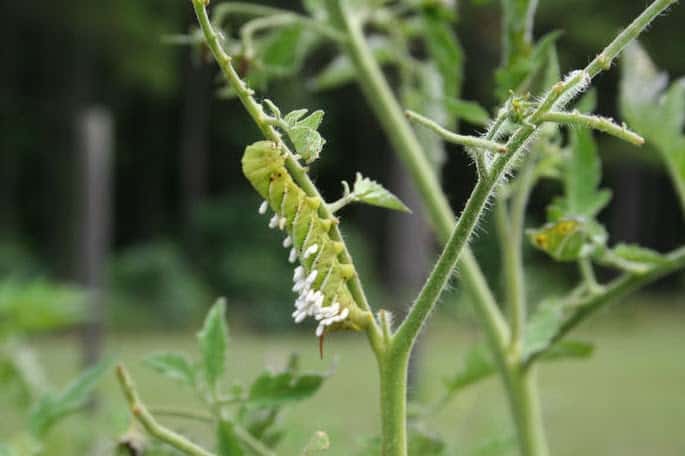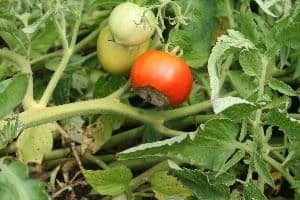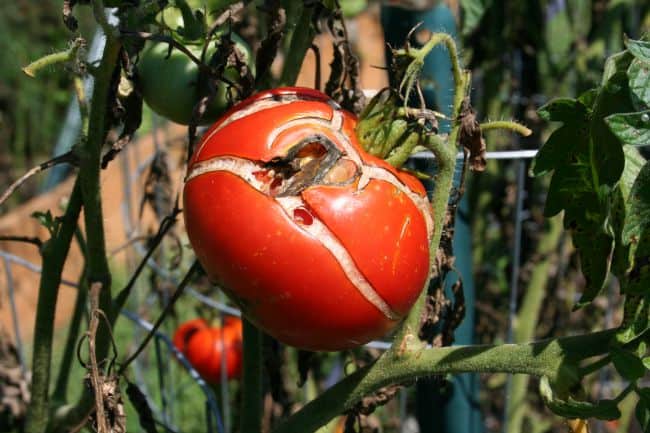Every gardener encounters tomato diseases at some point. Whether it’s ugly black spots on tomatoes that force you to throw them away or giant green worms eating everything in sight, tomato diseases and tomato plant problems are no fun. Here’s how to identify and fix the most common tomato plant problems.

Tomato Plant Problems Are a Pain!
I’ve been growing tomatoes for over 25 years. I’ve grown them in pots on a deck, in raised beds in a New York City area garden, and today, in raised beds and containers here in my Virginia garden. I love homegrown tomatoes.
But sometimes…tomatoes don’t love me! Tomato diseases take over.
Recognize any of these signs?
- Cracked tomatoes
- Black spots on the ends of the tomatoes
- Yellow leaves with brown spots, leaves turn gray and curl up
- Giant green worms on the plants eating all the leaves
- Holes in the tomatoes and a worm inside
Yes, my friends, these are the most common tomato diseases and tomato plant problems I’ve encountered in my garden. I’ll explain and show pictures of each one then give you an organic solution for each of the tomato diseases and problems mentioned.
The following includes affiliate links. We participate in the Amazon Services LLC Associates Program, an affiliate advertising program designed to provide a means for us to earn fees by linking to Amazon and affiliate sites. Thanks so much for being a part of Home Garden Joy!
Five Tomato Diseases and How to Fix Them
Tomato Hornworm
Problem:
The tomato hornworm strikes at night, chomping at the tender green leaves of your tomato plants. When you greet the morning, a naked tomato plant meets your eyes. Tomato hornworms strip plants overnight or within days. Eventually, they metamorphose into Manduca quinquemaculata, the five-spotted hawkmoth. But not before they damage plants.

Organic Solution:
Pick the hornworms off by hand and destroy them in a bucket of soapy water. Companion planting works well to repel tomato hornworms, too. Marigolds, especially the old-fashioned dark orange, highly scented kind of marigolds, do keep hornworms away.
Tomato Fruitworm
Problem:
You find holes in the green, unripe tomatoes. When you cut the ripe tomato open, a little worm falls out of the tomato. The area near the worm displays damaged fruit – gray, mealy, nasty. This is the tomato fruitworm, also called the corn earworm, Helicoverpa zea. The adult moth lays her egg in the soil, and when it turns into larva (the worm you see), it crawls up and burrows into the tomato or corn ear.

Organic Solution
The best defense is a good offense. Rotate crops and try not to plant corn or tomatoes in the same spot each year. Organic sprays containing B.T., a natural bacterial product, can also help. Remove any infected tomatoes and throw them in the trash. You really can’t eat them after the tomato fruitworm has gotten inside (plus, who would want to?)
Blossom End Rot
Problem
Tomatoes show a black, flat spot on the bottom. When you cut into the tomato, the black area is spongy, mealy, and nasty. This is called blossom end rot, and it’s a problem found in both tomatoes and peppers. It’s caused by a lack of calcium. Tomatoes either can’t absorb the available calcium because the soil pH isn’t right or the soil lacks calcium and magnesium, which is needed for proper mineral absorption by the plant.

Organic Solution
This is one tomato disease or tomato problem that calls for that ubiquitous product found in a zillion pins – Epsom salts. Epsom salts are actually a chemical called magnesium sulfate (not salt – never put salt in your garden!). Magnesium sulfate crystals dissolve and provide much-needed trace minerals for plants. I add a tablespoon of Epsom salts around each tomato plant a week or two after planting. It seems to prevent blossom end rot or, if I do get some blossom end rot, it’s only in the first few fruits, and after that, it goes away.
Cracked Tomatoes
Problem
Tomatoes crack in concentric circles around the tops or throughout the whole tomato. Birds love the cracks because they can get their beaks into the tomato and split them open for a meal. Mold or fungus gets into the cracks too and destroys the tomatoes right on the plant. These cracks are caused by too much water or uneven watering.
Think of the tomato skin like a balloon. If you blow up a balloon slowly, it expands but doesn’t pop. If you blow it up too quickly or too much, it pops because the skin can’t stretch enough to accommodate the air or helium.
A very similar thing happens with tomatoes when it rains a lot or you water heavily only once in a while. The skin normally expands through cell division as the tomato makes more skin cells to enlarge the fruit. But if a sudden surge of water comes into the fruit via root absorption, the skin can’t expand quickly enough. It cracks instead.

Organic Solution
While you can’t control rainwater, you can make sure that your watering practices are helpful rather than hurt your tomatoes. Water regularly about the same amount each time. This keeps the moisture consistent and prevents the sudden surge of water into the tomatoes.
Leaves Turn Yellow with Spots
Among all the tomato diseases, this one arrives like clockwork. Every year here in Virginia, my plants get septoria leaf spot, sometimes early like this year and sometimes later. Either way, the foliage turns yellow, develops the telltale black or brown spots, then curls up and turns gray. It won’t kill the plant, but it will lower the yield if it gets really bad.


Organic Solution
According to Virginia Tech, septoria leaf spot develops when fungal spores splash up from the soil and moist, humid conditions encourage their growth. The lower canopy of tomato plants is most susceptible. Planting tomatoes far enough apart, using tomato cages to space them, and crop rotation helps, as does pulling up and discarding spent tomato plants at the end of the season. You can also use an organic fungicide, applied weekly, to help control tomato diseases like septoria leaf spot.

Tomato Problems and Diseases – You’ll Still Get Tomatoes
One of the things I love about tomatoes is that even with all of these tomato plant problems and diseases, I still get tomatoes. You will, too. Even if your plants look a mess (and mine do by the end of the season), there are still a few tomatoes left. And boy, what tomatoes they are. Store-bought tomatoes never taste as good as the fresh taste of a homegrown tomato. So keep growing them – they are worth the effort!
My book – Plan and Build a Raised Bed Vegetable Garden






